Jianzong Wang
EMO-RL: Emotion-Rule-Based Reinforcement Learning Enhanced Audio-Language Model for Generalized Speech Emotion Recognition
Sep 19, 2025Abstract:Although Large Audio-Language Models (LALMs) have exhibited outstanding performance in auditory understanding, their performance in affective computing scenarios, particularly in emotion recognition, reasoning, and subtle sentiment differentiation, remains suboptimal. Recent advances in Reinforcement Learning (RL) have shown promise in improving LALMs' reasoning abilities. However, two critical challenges hinder the direct application of RL techniques to Speech Emotion Recognition (SER) tasks: (1) convergence instability caused by ambiguous emotional boundaries and (2) limited reasoning ability when using relatively small models (e.g., 7B-parameter architectures). To overcome these limitations, we introduce EMO-RL, a novel framework incorporating reinforcement learning with two key innovations: Emotion Similarity-Weighted Reward (ESWR) and Explicit Structured Reasoning (ESR). Built upon pretrained LALMs, our method employs group-relative policy optimization with emotion constraints. Comprehensive experiments demonstrate that our EMO-RL training strategies can significantly enhance the emotional reasoning capabilities of LALMs, attaining state-of-the-art results on both the MELD and IEMOCAP datasets, and cross-dataset experiments prove the strong superiority of generalization.
MoQAE: Mixed-Precision Quantization for Long-Context LLM Inference via Mixture of Quantization-Aware Experts
Jun 09, 2025Abstract:One of the primary challenges in optimizing large language models (LLMs) for long-context inference lies in the high memory consumption of the Key-Value (KV) cache. Existing approaches, such as quantization, have demonstrated promising results in reducing memory usage. However, current quantization methods cannot take both effectiveness and efficiency into account. In this paper, we propose MoQAE, a novel mixed-precision quantization method via mixture of quantization-aware experts. First, we view different quantization bit-width configurations as experts and use the traditional mixture of experts (MoE) method to select the optimal configuration. To avoid the inefficiency caused by inputting tokens one by one into the router in the traditional MoE method, we input the tokens into the router chunk by chunk. Second, we design a lightweight router-only fine-tuning process to train MoQAE with a comprehensive loss to learn the trade-off between model accuracy and memory usage. Finally, we introduce a routing freezing (RF) and a routing sharing (RS) mechanism to further reduce the inference overhead. Extensive experiments on multiple benchmark datasets demonstrate that our method outperforms state-of-the-art KV cache quantization approaches in both efficiency and effectiveness.
Hierarchical-Task-Aware Multi-modal Mixture of Incremental LoRA Experts for Embodied Continual Learning
Jun 05, 2025Abstract:Previous continual learning setups for embodied intelligence focused on executing low-level actions based on human commands, neglecting the ability to learn high-level planning and multi-level knowledge. To address these issues, we propose the Hierarchical Embodied Continual Learning Setups (HEC) that divide the agent's continual learning process into two layers: high-level instructions and low-level actions, and define five embodied continual learning sub-setups. Building on these setups, we introduce the Task-aware Mixture of Incremental LoRA Experts (Task-aware MoILE) method. This approach achieves task recognition by clustering visual-text embeddings and uses both a task-level router and a token-level router to select the appropriate LoRA experts. To effectively address the issue of catastrophic forgetting, we apply Singular Value Decomposition (SVD) to the LoRA parameters obtained from prior tasks, preserving key components while orthogonally training the remaining parts. The experimental results show that our method stands out in reducing the forgetting of old tasks compared to other methods, effectively supporting agents in retaining prior knowledge while continuously learning new tasks.
Generalized Audio Deepfake Detection Using Frame-level Latent Information Entropy
Apr 15, 2025



Abstract:Generalizability, the capacity of a robust model to perform effectively on unseen data, is crucial for audio deepfake detection due to the rapid evolution of text-to-speech (TTS) and voice conversion (VC) technologies. A promising approach to differentiate between bonafide and spoof samples lies in identifying intrinsic disparities to enhance model generalizability. From an information-theoretic perspective, we hypothesize the information content is one of the intrinsic differences: bonafide sample represents a dense, information-rich sampling of the real world, whereas spoof sample is typically derived from lower-dimensional, less informative representations. To implement this, we introduce frame-level latent information entropy detector(f-InfoED), a framework that extracts distinctive information entropy from latent representations at the frame level to identify audio deepfakes. Furthermore, we present AdaLAM, which extends large pre-trained audio models with trainable adapters for enhanced feature extraction. To facilitate comprehensive evaluation, the audio deepfake forensics 2024 (ADFF 2024) dataset was built by the latest TTS and VC methods. Extensive experiments demonstrate that our proposed approach achieves state-of-the-art performance and exhibits remarkable generalization capabilities. Further analytical studies confirms the efficacy of AdaLAM in extracting discriminative audio features and f-InfoED in leveraging latent entropy information for more generalized deepfake detection.
MADLLM: Multivariate Anomaly Detection via Pre-trained LLMs
Apr 13, 2025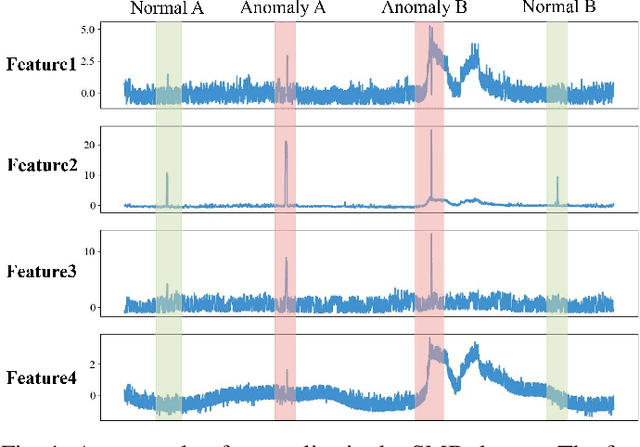
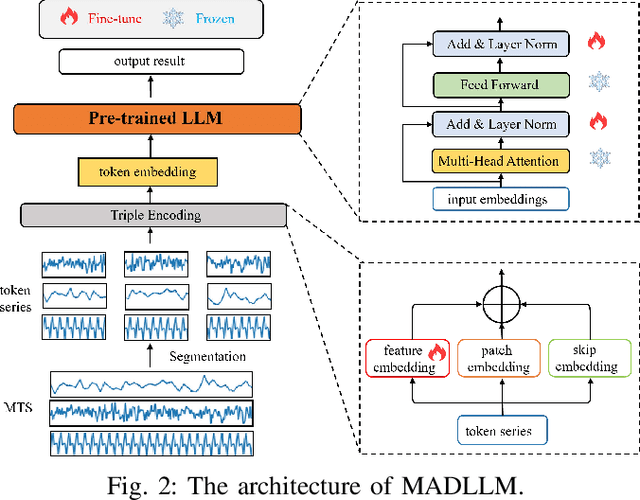
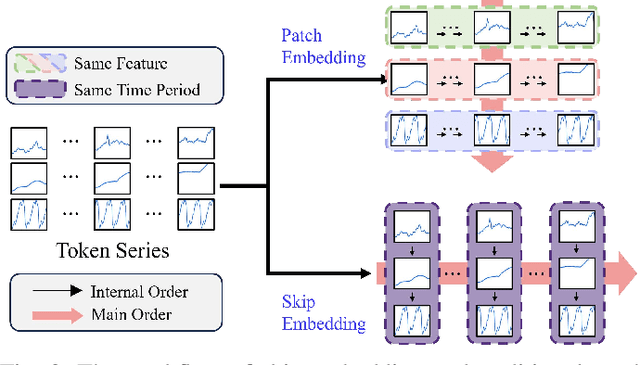

Abstract:When applying pre-trained large language models (LLMs) to address anomaly detection tasks, the multivariate time series (MTS) modality of anomaly detection does not align with the text modality of LLMs. Existing methods simply transform the MTS data into multiple univariate time series sequences, which can cause many problems. This paper introduces MADLLM, a novel multivariate anomaly detection method via pre-trained LLMs. We design a new triple encoding technique to align the MTS modality with the text modality of LLMs. Specifically, this technique integrates the traditional patch embedding method with two novel embedding approaches: Skip Embedding, which alters the order of patch processing in traditional methods to help LLMs retain knowledge of previous features, and Feature Embedding, which leverages contrastive learning to allow the model to better understand the correlations between different features. Experimental results demonstrate that our method outperforms state-of-the-art methods in various public anomaly detection datasets.
Cocktail: Chunk-Adaptive Mixed-Precision Quantization for Long-Context LLM Inference
Mar 30, 2025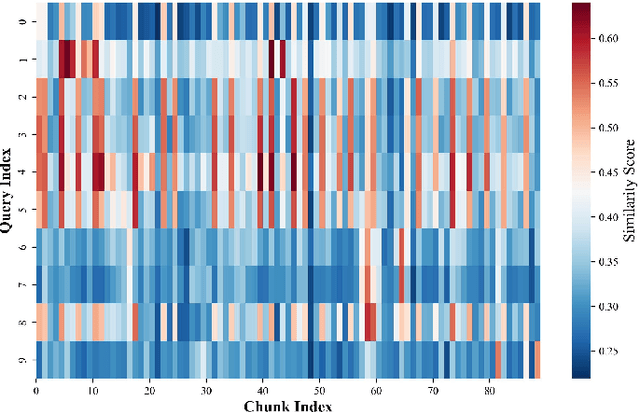
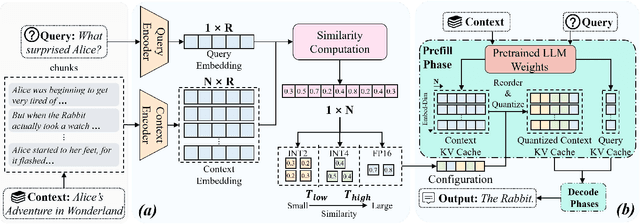
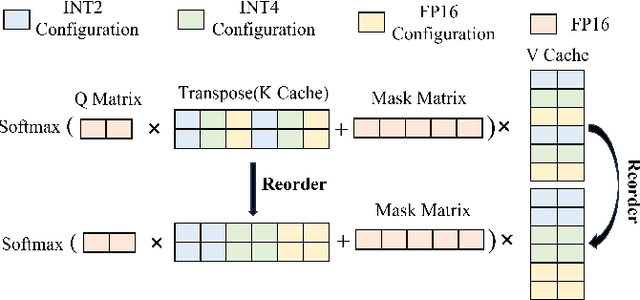
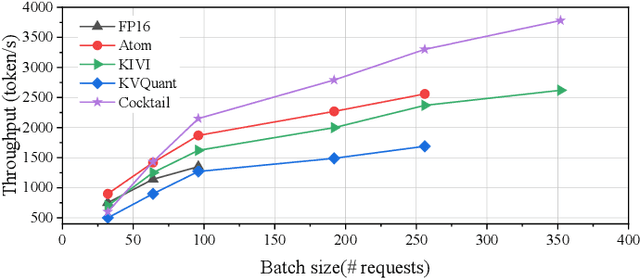
Abstract:Recently, large language models (LLMs) have been able to handle longer and longer contexts. However, a context that is too long may cause intolerant inference latency and GPU memory usage. Existing methods propose mixed-precision quantization to the key-value (KV) cache in LLMs based on token granularity, which is time-consuming in the search process and hardware inefficient during computation. This paper introduces a novel approach called Cocktail, which employs chunk-adaptive mixed-precision quantization to optimize the KV cache. Cocktail consists of two modules: chunk-level quantization search and chunk-level KV cache computation. Chunk-level quantization search determines the optimal bitwidth configuration of the KV cache chunks quickly based on the similarity scores between the corresponding context chunks and the query, maintaining the model accuracy. Furthermore, chunk-level KV cache computation reorders the KV cache chunks before quantization, avoiding the hardware inefficiency caused by mixed-precision quantization in inference computation. Extensive experiments demonstrate that Cocktail outperforms state-of-the-art KV cache quantization methods on various models and datasets.
VisTa: Visual-contextual and Text-augmented Zero-shot Object-level OOD Detection
Mar 28, 2025Abstract:As object detectors are increasingly deployed as black-box cloud services or pre-trained models with restricted access to the original training data, the challenge of zero-shot object-level out-of-distribution (OOD) detection arises. This task becomes crucial in ensuring the reliability of detectors in open-world settings. While existing methods have demonstrated success in image-level OOD detection using pre-trained vision-language models like CLIP, directly applying such models to object-level OOD detection presents challenges due to the loss of contextual information and reliance on image-level alignment. To tackle these challenges, we introduce a new method that leverages visual prompts and text-augmented in-distribution (ID) space construction to adapt CLIP for zero-shot object-level OOD detection. Our method preserves critical contextual information and improves the ability to differentiate between ID and OOD objects, achieving competitive performance across different benchmarks.
RUNA: Object-level Out-of-Distribution Detection via Regional Uncertainty Alignment of Multimodal Representations
Mar 28, 2025Abstract:Enabling object detectors to recognize out-of-distribution (OOD) objects is vital for building reliable systems. A primary obstacle stems from the fact that models frequently do not receive supervisory signals from unfamiliar data, leading to overly confident predictions regarding OOD objects. Despite previous progress that estimates OOD uncertainty based on the detection model and in-distribution (ID) samples, we explore using pre-trained vision-language representations for object-level OOD detection. We first discuss the limitations of applying image-level CLIP-based OOD detection methods to object-level scenarios. Building upon these insights, we propose RUNA, a novel framework that leverages a dual encoder architecture to capture rich contextual information and employs a regional uncertainty alignment mechanism to distinguish ID from OOD objects effectively. We introduce a few-shot fine-tuning approach that aligns region-level semantic representations to further improve the model's capability to discriminate between similar objects. Our experiments show that RUNA substantially surpasses state-of-the-art methods in object-level OOD detection, particularly in challenging scenarios with diverse and complex object instances.
Enhancing Multi-Agent Systems via Reinforcement Learning with LLM-based Planner and Graph-based Policy
Mar 13, 2025Abstract:Multi-agent systems (MAS) have shown great potential in executing complex tasks, but coordination and safety remain significant challenges. Multi-Agent Reinforcement Learning (MARL) offers a promising framework for agent collaboration, but it faces difficulties in handling complex tasks and designing reward functions. The introduction of Large Language Models (LLMs) has brought stronger reasoning and cognitive abilities to MAS, but existing LLM-based systems struggle to respond quickly and accurately in dynamic environments. To address these challenges, we propose LLM-based Graph Collaboration MARL (LGC-MARL), a framework that efficiently combines LLMs and MARL. This framework decomposes complex tasks into executable subtasks and achieves efficient collaboration among multiple agents through graph-based coordination. Specifically, LGC-MARL consists of two main components: an LLM planner and a graph-based collaboration meta policy. The LLM planner transforms complex task instructions into a series of executable subtasks, evaluates the rationality of these subtasks using a critic model, and generates an action dependency graph. The graph-based collaboration meta policy facilitates communication and collaboration among agents based on the action dependency graph, and adapts to new task environments through meta-learning. Experimental results on the AI2-THOR simulation platform demonstrate the superior performance and scalability of LGC-MARL in completing various complex tasks.
ACCon: Angle-Compensated Contrastive Regularizer for Deep Regression
Jan 13, 2025



Abstract:In deep regression, capturing the relationship among continuous labels in feature space is a fundamental challenge that has attracted increasing interest. Addressing this issue can prevent models from converging to suboptimal solutions across various regression tasks, leading to improved performance, especially for imbalanced regression and under limited sample sizes. However, existing approaches often rely on order-aware representation learning or distance-based weighting. In this paper, we hypothesize a linear negative correlation between label distances and representation similarities in regression tasks. To implement this, we propose an angle-compensated contrastive regularizer for deep regression, which adjusts the cosine distance between anchor and negative samples within the contrastive learning framework. Our method offers a plug-and-play compatible solution that extends most existing contrastive learning methods for regression tasks. Extensive experiments and theoretical analysis demonstrate that our proposed angle-compensated contrastive regularizer not only achieves competitive regression performance but also excels in data efficiency and effectiveness on imbalanced datasets.
 Add to Chrome
Add to Chrome Add to Firefox
Add to Firefox Add to Edge
Add to Edge